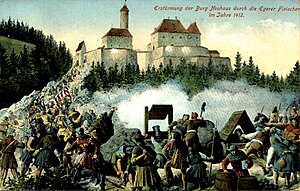Neuhaus Castle on the Eger
| Neuhaus on the Eger | ||
|---|---|---|
|
Siege of Neuhaus Castle in 1412 |
||
| Creation time : | around 1380 | |
| Castle type : | Höhenburg, summit location | |
| Conservation status: | Small remains of the wall, parts of the trench | |
| Standing position : | Ministerialenburg | |
| Construction: | Quarry stone | |
| Place: | Neuhaus on the Eger | |
| Geographical location | 50 ° 6 '36 " N , 12 ° 9' 48" E | |
| Height: | 586.8 m above sea level NN | |
|
|
||
The castle ruin Neuhaus an der Eger is the ruin of a hilltop castle at 586.8 m above sea level. NN on the wooded hilltop of the Schlossberg northwest of the Neuhaus an der Eger district of the town of Hohenberg an der Eger in the Wunsiedel district in the Fichtel Mountains in Bavaria .
history
Erhard Forster von Selb, a loyal supporter of King Wenzel , who remained loyal to him even after his deposition as Roman King in 1400, had in 1380 between Hohenberg Castle , which at that time had been owned by Zollern for around 100 years , and Thierstein Castle whose owners, the Lords of Notthracht , were partly in the service of the Burgraves of Nuremberg, built Neuhaus Castle on the Eger. This new Bohemian castle was supposed to slow down the expansion efforts of the Hohenzollern in the later Sechsämterland .
After his overthrow, King Wenzel refused the support he had promised the lords of Neuhaus. Erhard Forster attempted to express his demands against Wenzel by attacking the Bohemian subjects in the Egerland since 1322 . Ultimately, this protracted feud led to the destruction of Neuhaus Castle on August 27, 1412 by troops of the so-called Eger Unification . The Eger guilds , which distinguished themselves when conquering the castle, brought the tower decoration of the keep, the so-called Golden Sun from Neuhaus, to Eger , where it adorned the tower of the medieval town hall for a long time. Today this war trophy from 1412 is exhibited in the Eger City Museum. Although the captured Forster had to sell their property to the Egerer, after their release they declared this forced purchase invalid and in the same year sold all their property around Selb to the burgrave Johann III. from Nuremberg .
In 1487 the Margraves Friedrich and Sigmund zu Brandenburg lent the destroyed Neuhaus Castle to the Lords of Schirnding with the instruction to rebuild it. An entry in the land register of the six offices from 1499 proves that they complied with this request . It has not yet been clarified when the castle was abandoned by the Schirndingers. The cartographer Johann Christoph Stierlein completed a very precise map of the castle area for the first time in 1816 with the existing inventory.
description
The ruins of Neuhaus Castle, which was still impressive in the 19th century and which rose on a basalt knoll high above the Eger valley , fell victim to a basalt quarry in the 20th century. Historical views and plans, as well as the small remains of the castle that can still be identified today, suggest that a gate located northwest of the moat that is still present today and carved into the basalt rock provided access to a forecourt north of the inner castle . To the south of it rose the core castle formed by two building complexes separated from one another by a section ditch. The building of the core castle, which is located to the north and was built on a rectangular floor plan, fell victim to the basalt mining almost completely, while the section trench and the foundations of the southern building complex were preserved. In front of the southern building complex at the southeast corner was a round tower , probably the keep that once carried the Golden Sun as a tower decoration, the remains of which have now almost completely crashed into the former basalt quarry below.
Neuhaus Castle on the Eger
According to the description of the Neuhaus manor from 1697, the old castle had been in ruins for more than 150 years. By the end of the 18th century, under the rule of the Lords of Schirnding, a sizable village had developed at the foot of the castle hill, in which Friedrich Ernst von Schirnding had a castle built in 1770.
investment
Neuhaus Castle is an unadorned, two-story solid building. It hardly differs from the surrounding stately farmhouses. Above the door to the house there is a building inscription from 1770 with the Schirnding- Lindenfels alliance coat of arms . The quarry stone wall of the castle courtyard is partially present, the farm buildings attached to the north have been modernized.
literature
- Michael Brix , Karl-Ludwig Lippert : Former district of Rehau and town of Selb . In: Die Kunstdenkmäler von Bayern , Kurzinventare, XXXIV. Band . Deutscher Kunstverlag , Munich 1974, pp. 44–46.
- Heinrich Gradl : The reduction of the Egerland . In: Archive for the history and antiquity of Upper Franconia . 15th volume, 3rd issue. Bayreuth 1883, pp. 1-89.
- Harald Stark : Castles in the Fichtel Mountains . In: Contributions to the history and regional studies of the Fichtelgebirge . Issue 10. Wunsiedel 1988, pp. 8-10.
- Harald Stark: Neuhaus an der Eger - From the desert near the old castle to the village . In: The storyteller from Gabelmannsplatz, local supplement Frankenpost / Sechsämterbote No. 30 October 1997.
- Hans Vollet, Kathrin Heckel: The ruins drawings of the Plassenburg cartographer Johann Christoph Stierlein . 1987.




